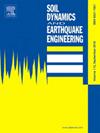Study on anti-dislocation design parameters of tunnel structure with flexible joints crossing fault based on simplified analytical method
IF 4.2
2区 工程技术
Q1 ENGINEERING, GEOLOGICAL
引用次数: 0
Abstract
The tunnel structure is susceptible to shear failure due to fault dislocation action, particularly in regions with high seismic activity. To mitigate this risk, the use of tunnel segmental lining and flexible joints has been identified as an effective anti-dislocation strategy. However, the design of these components lacks available analytical solutions. To address this gap, a simplified longitudinal beam-spring tunnel model has been developed to assess the longitudinal response of tunnel structures, incorporating the splaying and staggering deformations at flexible joints. The virtual node method is employed to efficiently solve the problem of discontinuous deformation at these joints.
An analytical solution for the longitudinal response of tunnels with flexible joints subjected to fault dislocation is derived utilizing the established governing equations, continuity conditions at the flexible joints and boundary conditions. The validity of the proposed solution is confirmed through comparisons with results from model tests and numerical simulations. Subsequently, a sensitivity analysis is conducted to explore the effects of segmental lining length, flexible joint parameters, and fault zone width. The findings reveal that flexible joints significantly enhance the anti-dislocation capability of tunnel structures, reducing the longitudinal strain of tunnel linings by 57.68 %. Furthermore, the anti-dislocation performance can be further improved by decreasing the stiffness of the flexible joints. Notably, the flexible joints located at the interface between the fault zone and the moving or fixed block endure the most shear and rotational deformations. Additionally, a negative correlation is observed between the required width of flexible joints and the length of segmental lining.
求助全文
约1分钟内获得全文
求助全文
来源期刊

Soil Dynamics and Earthquake Engineering
工程技术-地球科学综合
CiteScore
7.50
自引率
15.00%
发文量
446
审稿时长
8 months
期刊介绍:
The journal aims to encourage and enhance the role of mechanics and other disciplines as they relate to earthquake engineering by providing opportunities for the publication of the work of applied mathematicians, engineers and other applied scientists involved in solving problems closely related to the field of earthquake engineering and geotechnical earthquake engineering.
Emphasis is placed on new concepts and techniques, but case histories will also be published if they enhance the presentation and understanding of new technical concepts.
 求助内容:
求助内容: 应助结果提醒方式:
应助结果提醒方式:


